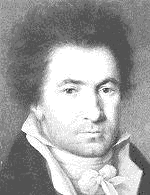Theme-and-Variations form was commonly used for the second (slow) movement of a classical symphony. That's not to say that all slow movements were sets of theme-annd-variations. Sometimes composersused instead a simple song form or ABA form. As with any form, the form itself does not prescribe a specific instrumentation; it is merely a structure and/or guide for composing. While certain gestures might be more common for specific forms, and similarly certain "topics" (musical styles) might be more appropriate for one form over another, the forms themselves should be understood as simply a syntax, or grammatical arrangement, of musical units within a particular composition or movement.
In theme and variations, a theme is presented, usually fully harmonized, and then successively varied with each repetition.
The earliest classical theme-and-variations proceeded by ornamenting the melody with smaller and smaller note values with each subsequent variation. First a melody might be varied by using triplets (three notes for every pulse) in the melody; this would be followed by using triplets in the accompaniment; then sixteenth notes in the melody; then sixteenth notes in the accompaniment and so forth; next, composers would perhaps present the tune in a minor key and so on. This style of variation is more Rococo and devotes as much attention to the virtuosity of the performer as the ornamentation of the melody.
As the genre developed, composers found new ways to vary the melody: they could change note durations; compose using different "topics" / styles such as a Turkish March, or other dance forms or the style of Renaissance polyphony; change from the major mode to the minor mode; set the melody as if it were a virtuosic opera aria or anything else the composer could come up with. In some instances In some cases, however, the exact meaning of the semiotic code of these topics has been lost. Beethoven's Variations on God Save the King for piano is a particularly clear example of a classical variation strategy.

Ludwig van Beethoven (1770-1827)